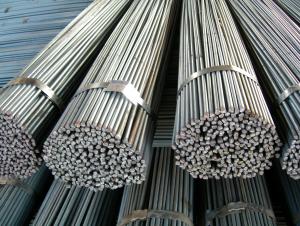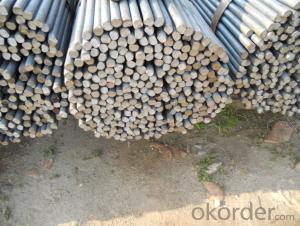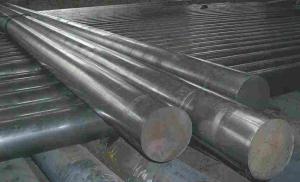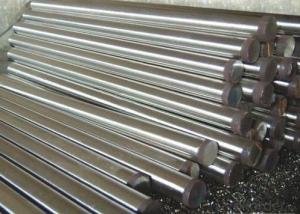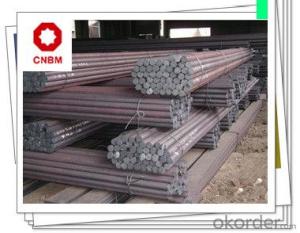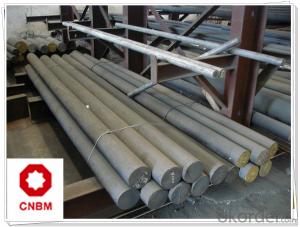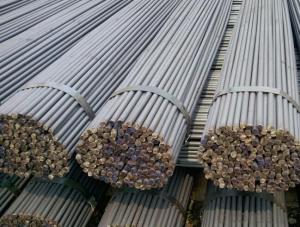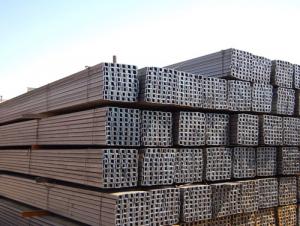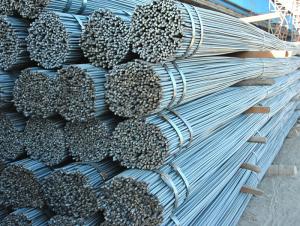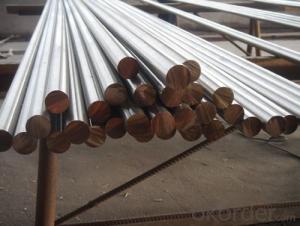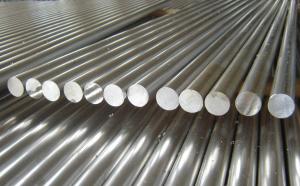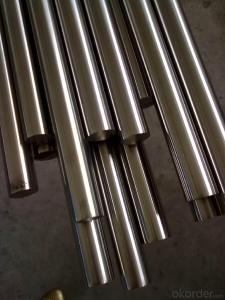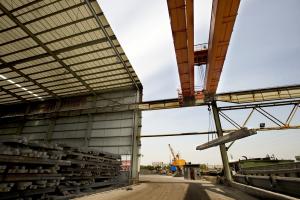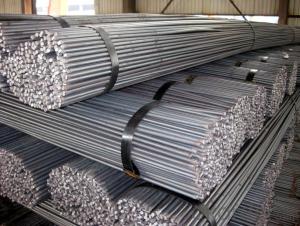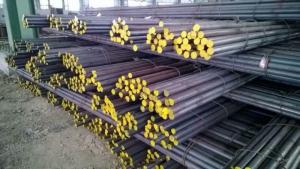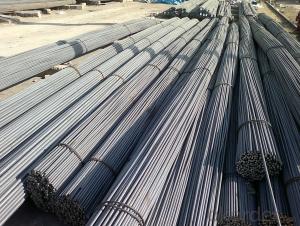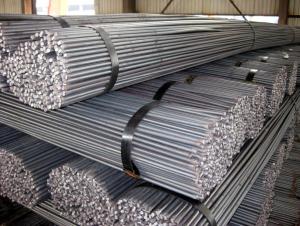Round Bar Q235 5MM-100MM Hot Rolled High Quality Q195
- Loading Port:
- China Main Port
- Payment Terms:
- TT or LC
- Min Order Qty:
- -
- Supply Capability:
- -
OKorder Service Pledge
OKorder Financial Service
You Might Also Like
Product Description:
OKorder is offering Round Bar Q235 5MM-100MM Hot Rolled High Quality Q195 at great prices with worldwide shipping. Our supplier is a world-class manufacturer of steel, with our products utilized the world over. OKorder annually supplies products to European, North American and Asian markets. We provide quotations within 24 hours of receiving an inquiry and guarantee competitive prices.
Product Applications:
1) Suitable for making various strong cutting tool abrasion resistance, impact resistance.
2) Used to produce all kinds of high hard and super hard saw blade, drill, tap, broach, gear hob and various kinds of milling cutter.
3) Used for advanced punching die, screw die, and the toughness and complicated shape of the punch, etc.
4) Is used for cold forging die and drawing mode, etc.
5) Recommended watchcase factory, screw factory and other cold stamping products industry use.
Product Advantages:
OKorder's Round Bar Q235 5MM-100MM Hot Rolled High Quality Q195 are durable, strong, and resist corrosion.
Main Product Features:
· Premium quality
· Prompt delivery & seaworthy packing (30 days after receiving deposit)
· Corrosion resistance
· Can be recycled and reused
· Mill test certification
· Professional Service
· Competitive pricing
Product Specifications:
1. Grade: GB, JIS, ASTM, EN
2. Grade: Q235, SS400, A36, S235JR
3. Diameter and mass: As below
Diameter | Mass | Diameter | Mass | Diameter | Mass |
(mm) | (kg/m) | (mm) | (kg/m) | (mm) | (kg/m) |
6 | 0.22 | 22 | 2.98 | 53 | 17.30 |
7 | 0.30 | 24 | 3.55 | 56 | 19.30 |
8 | 0.40 | 25 | 3.85 | 60 | 22.20 |
9 | 0.50 | 26 | 4.17 | 63 | 24.50 |
10 | 0.62 | 28 | 4.83 | 65 | 26.00 |
11 | 0.75 | 30 | 5.55 | 70 | 30.20 |
12 | 0.89 | 32 | 6.31 | 75 | 34.70 |
13 | 1.04 | 34 | 7.13 | 80 | 39.50 |
14 | 1.21 | 36 | 7.99 | 85 | 44.50 |
15 | 1.39 | 38 | 8.90 | 90 | 49.90 |
16 | 1.58 | 40 | 9.86 | 95 | 55.60 |
17 | 1.78 | 42 | 10.90 | 100 | 61.70 |
18 | 2.00 | 45 | 12.50 | 120 | 88.85 |
19 | 2.23 | 48 | 14.20 | 140 | 120.93 |
20 | 2.47 | 50 | 15.40 | 150 | 138.82 |
4. Material: Mild Steel
5. Heat treatment of high quality steel:
Fire: Isothermal annealing temperature is 800 ~ 880 °C, with 10 ~ 20 °C, the furnace cooling to about 600 °C, hardness above HB269.
Preheat temperature: 730-730 °C
Quenching temperature: 1190-1210 °C
Tempering temperature: 540-595 °C
Cold drawn, hardness 285 HBS
Cold drawn after annealing condition, hardness 277 HBS
Quenching methods: oil quenching, air cooling or salt bath quenching
FAQ:
Q1: Why buy Materials & Equipment from OKorder.com?
A1: All products offered byOKorder.com are carefully selected from China's most reliable manufacturing enterprises. Through its ISO certifications, OKorder.com adheres to the highest standards and a commitment to supply chain safety and customer satisfaction.
Q2: How do we guarantee the quality of our products?
A2: We have established an advanced quality management system which conducts strict quality tests at every step, from raw materials to the final product. At the same time, we provide extensive follow-up service assurances as required.
Q3: The products are invoicing on theoritical weight or on actual weight?
A3: We can do it in both manners, according to the customers' request.
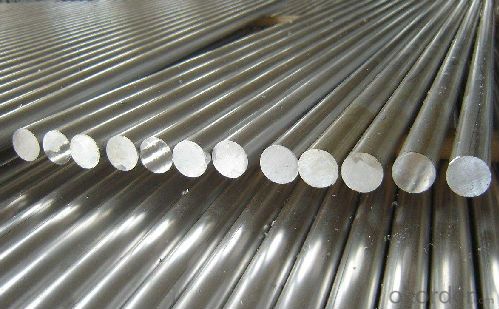

- Q: What is the difference between a centerless ground and a cold finished steel round bar?
- Both centerless ground steel round bars and cold finished steel round bars are types of steel bars that have undergone different manufacturing processes, resulting in distinct characteristics and properties. To produce a centerless ground steel round bar, a hot rolled or cold drawn steel bar is fed through a grinding machine. This grinding process eliminates any surface imperfections or irregularities, resulting in a smooth and uniform surface finish. Additionally, the centerless grinding process ensures precise dimensional tolerances, making the bar suitable for applications that require accurate measurements. Furthermore, centerless ground bars have improved straightness and roundness, enhancing their overall quality and suitability for various machining operations. On the other hand, a cold finished steel round bar is created by cold drawing or cold rolling a hot rolled steel bar. This process involves reducing the diameter of the bar while maintaining its length, resulting in a more precise and consistent size. Cold finishing also enhances the surface finish of the bar, making it smoother and more uniform. Cold finished bars have tighter dimensional tolerances and improved mechanical properties, including higher strength and hardness compared to hot rolled bars. In conclusion, the primary distinction between centerless ground and cold finished steel round bars lies in their manufacturing processes and resulting characteristics. Centerless ground bars possess a smooth surface finish, tight dimensional tolerances, improved straightness, and roundness, rendering them suitable for precise machining applications. On the other hand, cold finished bars offer a more precise size, improved surface finish, tighter dimensional tolerances, and enhanced mechanical properties, making them suitable for various applications requiring higher strength and hardness.
- Q: Can steel round bars be welded?
- Yes, steel round bars can be welded. Welding is a common method used to join steel round bars together. The process involves heating the steel bars to a high temperature and applying pressure to fuse them together. This allows for the creation of strong and durable connections between the steel round bars. However, it is important to ensure that the appropriate welding techniques and equipment are used to achieve a high-quality weld.
- Q: What is the elasticity of a steel round bar?
- The elasticity of a steel round bar refers to its ability to return to its original shape after being subjected to external forces or deformation. Steel is known for its high elasticity, meaning it can withstand significant stress and strain without permanent deformation. This property makes steel round bars suitable for various applications, including construction, manufacturing, and engineering.
- Q: How do you prevent steel round bars from rusting during storage?
- To prevent steel round bars from rusting during storage, it is important to keep them in a dry environment with low humidity. Applying a coating of protective oil or wax can also help create a barrier against moisture and prevent rust formation. Additionally, storing the bars off the ground and away from direct contact with concrete or other materials that may cause corrosion can further prevent rusting. Regular inspections and maintenance are crucial to ensure the bars remain rust-free.
- Q: Requirements for groove welding of grade 22mm round steel and manual arc welding
- If not on the lathe, in the groove on the round bar with gouging or cutting gun, docking form X type double sided bilateral docking, blunt edge 2mm root gap 2mm welding, welding side sincere one or two seam, flip the workpiece on the other side of a full weld groove, flip weld residual,
- Q: What are the tolerance levels for steel round bars?
- Steel round bars have varying tolerance levels depending on the specific application and industry standards. To ensure precision in terms of diameter, straightness, and surface finish, steel round bars are typically produced with tight dimensional tolerances. Diameter tolerances specify the acceptable range of deviation from the nominal diameter of the round bar and are expressed as a plus or minus value, such as +/- 0.005 inches. The specific tolerance depends on the size, type of steel round bar, and application requirements. Straightness tolerances determine the allowable amount of deviation from a perfectly straight line along the length of the round bar. This tolerance is expressed as the maximum distance between the round bar and a straight edge placed along its length. For instance, a straightness tolerance of 0.030 inches per foot means that a one-foot section of the round bar can deviate up to 0.030 inches from a straight line. Surface finish tolerances specify the acceptable level of imperfections or irregularities on the surface of the round bar. This tolerance is often expressed using roughness average (Ra) or roughness peak (Rz) values. The specific tolerance depends on the desired surface finish and application requirements. It is worth noting that tolerance levels may also be subject to industry-specific standards established by organizations like the American Society for Testing and Materials (ASTM) or the International Organization for Standardization (ISO). These standards provide guidelines and specifications for various steel products, including round bars, to ensure consistent quality and performance. Ultimately, determining the tolerance levels for steel round bars involves considering the specific application requirements, industry standards, and the capabilities of the manufacturing process.
- Q: Embedded bolts M24 why use M25 round steel?
- Why does the embedded bolt M24 use M25 round steel? Because there is no 24 of the bar specifications, only 25
- Q: How do you determine the strength and hardness of a steel round bar?
- To determine the strength and hardness of a steel round bar, several tests and techniques can be employed. One of the most common methods is the tensile strength test. In this test, a sample of the steel round bar is subjected to a gradually increasing load until it reaches its breaking point. The maximum load it can withstand before breaking is recorded, which gives an indication of the bar's strength. Hardness testing is another crucial measure of steel round bar quality. The Rockwell hardness test is frequently used, where a diamond or tungsten carbide ball is pressed into the surface of the bar with a specific load. The depth of the indentation made by the ball is measured, and the hardness value is determined based on a standardized scale. Additionally, the Brinell hardness test can be utilized, where a hardened steel ball is pressed into the surface of the round bar with a specific load. The diameter of the indentation formed is measured, and the hardness is calculated based on the applied load and the size of the indentation. Furthermore, there are non-destructive techniques such as ultrasonic testing and magnetic particle inspection that can provide information about the internal structure, defects, and cracks within the steel round bar, thus indirectly indicating its strength and hardness. It is important to note that various factors, including the composition of the steel, its heat treatment, and the manufacturing process, can influence the strength and hardness of a round bar. Therefore, it is advisable to consult standards and specifications that define the expected properties for the specific type of steel round bar being tested.
- Q: What is the difference between a hot-rolled and a cold-drawn steel round bar?
- The manufacturing process and resulting properties distinguish a hot-rolled steel round bar from a cold-drawn one. To produce hot-rolled bars, a billet or ingot is heated to a high temperature, typically around 1100 to 1300 degrees Celsius, and then rolled into the desired shape and size. This process yields a rougher surface finish and larger tolerances compared to cold-drawn bars. Hot-rolled bars exhibit less precision in dimensions and may contain surface defects such as scale or rust. In contrast, cold-drawn bars undergo manufacturing by pulling a hot-rolled bar through a die at room temperature. This process reduces the diameter and enhances the surface finish, resulting in a smoother and more precise product. Cold-drawing also improves the mechanical properties of the steel, including increased strength, hardness, and improved surface quality. The cold-drawing process provides closer dimensional tolerances, making cold-drawn bars suitable for applications that demand higher precision. In conclusion, the distinction between hot-rolled and cold-drawn steel round bars lies in the manufacturing process, resulting in differences in surface finish, dimensional tolerances, and mechanical properties. Hot-rolled bars are produced at high temperatures, possess a rougher surface, and have larger tolerances. On the other hand, cold-drawn bars are manufactured at room temperature, exhibit a smoother surface, closer dimensional tolerances, and enhanced mechanical properties. The choice between the two depends on specific application requirements and the desired characteristics of the final product.
- Q: What are the different types of steel round bar alloys for improved machinability and strength?
- There are several different types of steel round bar alloys that are specifically designed to offer improved machinability and strength. These alloys are commonly used in various industries where the ability to machine components efficiently while maintaining high tensile strength is crucial. Some of the most popular steel round bar alloys for improved machinability and strength include: 1. 12L14: This alloy contains lead, which acts as a lubricant during machining, resulting in improved chip formation and reduced tool wear. It offers excellent machinability and good strength, making it suitable for applications that require intricate machining processes. 2. 4140: Also known as "chromoly" steel, this alloy contains chromium and molybdenum, which enhance its strength and hardenability. 4140 steel round bars are widely used in applications that require high tensile strength, such as automotive parts, shafts, and gears. 3. 8620: This alloy is a low-alloy nickel-chromium-molybdenum steel that offers a combination of high strength and good toughness. It can be easily machined and is often used in applications that require case-hardening, such as gears, shafts, and fasteners. 4. 1018: Known as "cold-rolled" or "cold-finished" steel, 1018 is a low-carbon steel alloy that offers good machinability and weldability. It is commonly used in applications where precise and smooth finishes are required, such as in the manufacturing of bolts, screws, and hydraulic fittings. 5. 52100: This alloy is a high carbon, chromium-bearing steel that is primarily used in the manufacturing of bearings and other high-wear applications. It offers excellent hardness, wear resistance, and machinability, making it suitable for components that require high strength and durability. These are just a few examples of the different types of steel round bar alloys available for improved machinability and strength. The choice of alloy depends on the specific requirements of the application, such as the desired strength, machinability, and durability. Consulting with a materials engineer or supplier can help determine the most suitable alloy for a particular use case.
Send your message to us
Round Bar Q235 5MM-100MM Hot Rolled High Quality Q195
- Loading Port:
- China Main Port
- Payment Terms:
- TT or LC
- Min Order Qty:
- -
- Supply Capability:
- -
OKorder Service Pledge
OKorder Financial Service
Similar products
Hot products
Hot Searches
